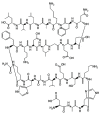A Review of Biodegradable Natural Polymer-Based Nanoparticles for Drug Delivery Applications
- PMID: 33027891
- PMCID: PMC7600772
- DOI: 10.3390/nano10101970
A Review of Biodegradable Natural Polymer-Based Nanoparticles for Drug Delivery Applications
Abstract
Biodegradable natural polymers have been investigated extensively as the best choice for encapsulation and delivery of drugs. The research has attracted remarkable attention in the pharmaceutical industry. The shortcomings of conventional dosage systems, along with modified and targeted drug delivery methods, are addressed by using polymers with improved bioavailability, biocompatibility, and lower toxicity. Therefore, nanomedicines are now considered to be an innovative type of medication. This review critically examines the use of natural biodegradable polymers and their drug delivery systems for local or targeted and controlled/sustained drug release against fatal diseases.
Keywords: biodegradable; drug delivery; nanoparticles; pharmaceutical; polymers.
Conflict of interest statement
The authors declare no conflict of interest.
Figures









References
-
- Sur S., Rathore A., Dave V., Reddy K.R., Chouhan R.S., Sadhu V. Recent developments in functionalized polymer nanoparticles for efficient drug delivery system. Nano Struct. Nano Objects. 2019;20:100397. doi: 10.1016/j.nanoso.2019.100397. - DOI
-
- Tong X., Pan W., Su T., Zhang M., Domg W., Qi X. Recent advances in natural polymer-based drug delivery systems. Reactive and Functional Polymers. React. Funct. Polym. 2020;148:104501. doi: 10.1016/j.reactfunctpolym.2020.104501. - DOI
-
- Tiyaboonchai W. Chitosan Nanoparticles: A Promising System for Drug Delivery. Naresuan Univ. J. 2003;11:51–66.
Publication types
LinkOut - more resources
Full Text Sources

